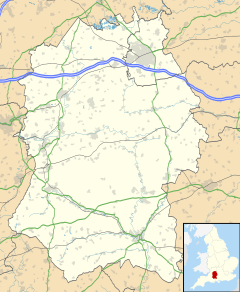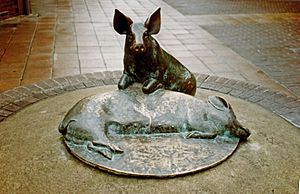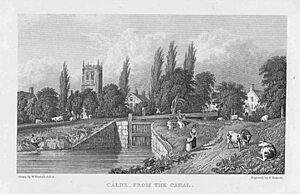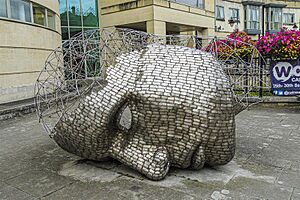Calne facts for kids
Quick facts for kids Calne |
|
|---|---|
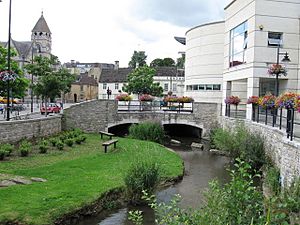 River Marden, Calne town centre |
|
 Flag |
|
| Population | 19,074 (2021 Census) |
| OS grid reference | ST997710 |
| Unitary authority |
|
| Ceremonial county | |
| Region | |
| Country | England |
| Sovereign state | United Kingdom |
| Post town | CALNE |
| Postcode district | SN11 |
| Dialling code | 01249 |
| Police | Wiltshire |
| Fire | Wiltshire |
| Ambulance | Great Western |
| EU Parliament | South West England |
| UK Parliament |
|
Calne is a lively town in Wiltshire, southwestern England. It's located at the edge of the North Wessex Downs, a beautiful area known for its natural scenery.
The town sits on the small River Marden, which starts just 2 miles (3 km) away. Calne is the only town built along this river. It's also on the A4 road, about 19 miles (30 km) east of Bath and 6 miles (10 km) east of Chippenham. In 2021, about 19,074 people lived in Calne.
Contents
- Calne's Past: A Look Back in Time
- Calne Today: Economy and Growth
- Arts, Culture, and Fun in Calne
- Important Buildings and Places
- Getting Around Calne
- Learning in Calne: Schools and Colleges
- Places of Worship
- Calne's Population
- Local Media
- How Calne is Governed
- Famous People from Calne
- Cool Places to Visit Near Calne
- Sports Teams in Calne
- Calne's Neighborhoods
- Twin Towns
- See also
Calne's Past: A Look Back in Time
In 978, during Anglo-Saxon times, something dramatic happened in Calne. A powerful leader named St Dunstan, who was the Archbishop of Canterbury, met with important people to talk about changes he wanted to make to the church.
According to stories from around 1000 AD, Dunstan asked God for help during this meeting. Suddenly, the floor of the building collapsed! Most of his opponents fell, but Dunstan and his supporters stayed on the part of the floor that remained standing. People at the time believed this was a miracle.
Becoming a Market Town
By 1086, Calne was likely already a busy market town. It had 114 households and a church. Many people owned their homes almost completely, like citizens of a special town called a borough.
In the Middle Ages, both the king and the church leaders in Calne could hold markets and fairs. There were two triangular market areas for these events. A small hospital was also set up in 1248 to help people, but it closed down later.
Calne's Industries: Wool and Pork
In the 1700s, Calne was famous for its woollen cloth industry. You can still see old buildings from this time around the church. Many of these are listed buildings, including old almshouses for the poor and homes of rich cloth makers. There were also 14 mills along the Marden River. Wealthy cloth merchants helped expand St Mary's church in the 1400s.
Many old houses from the 1600s and 1700s have stone outer walls and wooden frames inside. The stone often came from local quarries near the London road.
A leftover from the 1800s is a lime kiln at St Mary's School. Lime, made from a rock called calcium carbonate, was used in cement and as fertilizer.
Canals and Railways
The Wilts & Berks Canal connected Calne to other waterways, including the River Thames. It was finished in 1810 and brought coal from the Somerset Coalfield to the town. However, the canal was no longer used after 1914.
Calne railway station opened in 1863. It was the end of a train line that ran from Chippenham. The railway closed in 1965 because it wasn't used much.
The Famous Wiltshire Pork
After the railway closed, Calne's main industry became the C&T Harris pork factory. It's said that the pork business grew because pigs from Ireland were brought to Bristol and then walked across England to London. One place where the pigs rested was Black Dog Hill, near Calne. The Harris family, who were butchers, would buy the pigs that looked too tired to continue their journey.
The Harris business started in the late 1700s. The family developed a special way to cure bacon and ham, called the Wiltshire cure. By the 1930s, C&T Harris had a huge five-story factory in the town center. It employed 2,000 people and processed 5,000 pigs every week, making bacon, pies, and sausages.
However, the business started to decline in the 1970s due to competition. The factory closed in 1982 and was later taken down. Today, the site has homes and the town's library. A bronze sculpture of two pigs in the town center reminds everyone of Calne's pork history.
Calne Today: Economy and Growth
In the late 1990s and early 2000s, Calne grew very quickly. The population increased a lot. A large housing area called Lansdowne Park was built, adding new homes, a primary school, a medical center, and shops. Many people moved here from more expensive areas like Bath and Bristol. The name Lansdowne Park comes from the nearby Bowood House estate, owned by the Marquess of Lansdowne's family since 1784.
The Porte Marsh Industrial Estate is a big area with about 100 companies, mostly in light industries and technology. A Belgian company called Deceuninck has large production and distribution centers there. The Exception Group, an electronics maker, is also a major employer.
In 2009, the Beversbrook Sports Facility opened. It has many football pitches, cricket areas, tennis courts, and indoor sports facilities. This was built with funding from a housing development.
Shopping in Calne
Calne has several supermarkets, including Sainsbury's, Tesco, and Iceland. There's also a Tesco on the north side and an Asda Express on the south. The town center has been redeveloped, with new buildings and a modern look.
Arts, Culture, and Fun in Calne
The Calne Music & Arts Festival started in 1975 and happens every year. It's a popular event for the community.
In 2014, Calne won a Gold Award in the South West in Bloom competition for its beautiful floral displays and community projects.
Calne also has about twenty pieces of public art, like sculptures and murals. You can follow a special Public Art Trail to see them all.
Important Buildings and Places
Some important buildings in Calne include St Mary's Church, which is very old (from the 1100s) and is the only Grade I listed building in town. There are also many historic houses on The Green and the Calne Town Hall.
The Lansdowne Strand Hotel, an old inn, dates back to the 1600s.
Calne Library, opened by the Queen in 2001, has won awards for its cool design. After the Harris pork factory was taken down, new buildings in the town center were built using local stone and red brick, giving Calne a fresh look.
Getting Around Calne
The A4 road that goes through the town center can get very busy, especially during rush hour. A bypass road was built in 2000 to help with traffic.
Calne is about 12 miles (19 km) from the M4 motorway, which is a major highway. The closest main airport is Bristol Airport, about 38 miles (61 km) away. The nearest train stations are in Chippenham, Melksham, and Pewsey. Buses also connect Calne to nearby towns and cities like Chippenham, Devizes, Marlborough, Swindon, and Bath.
Learning in Calne: Schools and Colleges
Calne has a long history of education. Bentley's School opened in 1664. Over the years, it changed names and merged with other schools, eventually becoming the John Bentley School. In 2019, it was renamed Kingsbury Green Academy.
St Mary's School, an independent school for girls, was founded in 1873.
Many famous people attended schools in Calne, including Reg Birkett and Charlie Absolom, who both played sports for England in the 1870s.
The closest university is the University of Bath, about 19 miles (30 km) away. For further education, Wiltshire College & University Centre has a campus in Chippenham.
Calne has five primary schools and one independent preparatory school:
- Fynamore Primary School
- Holy Trinity CofE School
- Marden Vale CofE (VC) Academy
- Priestley Primary School
- Saint Edmund's RC Primary School
- St Margaret's Preparatory School
Places of Worship
Anglican Churches
St Mary's Church is in the center of Calne and dates back to the 1100s. It was made much bigger in the 1300s and 1400s. It's a very important historic building.
Holy Trinity church in Quemerford was built in 1852–53. Its churchyard became the main graveyard for the area.
Catholic Church
St Edmund's Catholic Church was built in 1962. It has special tiles from an old abbey and stained glass from another church.
Other Churches
Calne has a long history of different Christian groups.
- A Baptist church in Castle Street was built in the late 1600s and rebuilt several times. It's still used today.
- The Wesleyan Methodists built a chapel in 1811 and a larger church in 1867, which is still in use.
- The Free Church, built in 1868, is for a group that separated from the main parish church.
- There's also an Evangelical church in Oxford Road.
A cemetery for people of any faith opened in 1867 on Curzon Street.
Calne's Population
In 2021, Calne had 19,074 people living in the parish. The built-up area, which includes parts of Quemerford, had 19,732 people.
Here's how Calne's population has grown over the years:
| Year | 1801 | 1811 | 1821 | 1831 | 1841 | 1851 | 1881 | 1891 |
|---|---|---|---|---|---|---|---|---|
| Population | 3,767 | 3,547 | 4,549 | 4,795 | 5,128 | 5,117 | 5,194 | |
| Year | 1901 | 1911 | 1921 | 1931 | 1941 | 1951 | 1961 | |
| Population | 3,538 | 3,640 | 3,463 | 5,756 | 5,553 | 6,574 | ||
| Year | 2001 | 2011 | 2021 | |||||
| Population | 13,606 | 17,274 | 19,074 |
Local Media
For local news and music, Calne has BBC Radio Wiltshire and Heart West. There are also two online radio stations: Eartunes Radio and White Horse Radio.
Local TV news comes from BBC Points West and ITV News West Country.
How Calne is Governed
Calne is part of two different areas for the UK Parliament. Most of Calne is in the Chippenham area, while a southern part is in the Melksham and Devizes area. Both areas are currently represented by Liberal Democrat politicians.
At a local level, Calne is run by the Calne Town Council. They manage things like parks, events, and cemeteries. The town council has 19 members elected from four different areas.
Calne is also part of Wiltshire Council, which is a larger local government body. Five councillors from Calne are elected to Wiltshire Council.
| Ward | Party | Member | |
|---|---|---|---|
| Calne Central | Liberal Democrat | Ian Thorn | |
| Calne Chilvester and Abberd | Liberal Democrat | Robert MacNaughton | |
| Calne North | Conservative | Tom Rounds | |
| Calne Rural | Conservative | Ashley O'Neill | |
| Calne South | Liberal Democrat | Sam Pearce-Kearney | |
Famous People from Calne
- Edmund Rich (1175–1240) became the Archbishop of Canterbury. Many schools are named after him.
- John Pym (1584–1643) was a leader in Parliament and a critic of King Charles I. He was one of the "Five Members" whose attempted arrest helped start the English Civil War.
- Isaac Nichols (born 1770) was sent to Australia as a convict but became the first postmaster of Sydney.
- Joseph Priestley discovered oxygen in 1774 at Bowood House, near Calne. There's a plaque in town to remember this.
- Jan Ingenhousz also did experiments in Calne and found that sunlight helps plants create oxygen (photosynthesis).
- Samuel Taylor Coleridge, a famous poet, lived in Calne from 1814 to 1816.
- Walter Goodall George (1858–1943) was an amazing athlete who set many world records for running. There are two plaques in Calne to honor him.
- Sarah Grand (1854–1943), a feminist writer, lived in Calne at the end of her life. She created the phrase "The New Woman" and fought for women's rights.
- The composer Sir Michael Tippett lived near Calne.
- The actor David Hemmings lived in Calne for many years until he passed away in 2003.
Cool Places to Visit Near Calne
There are many interesting attractions close to Calne:
- Cherhill White Horse – This giant horse shape is carved into a hillside about 3.4 miles (5.5 km) east of Calne. You can see it clearly from the A4 road.
- Lansdowne Monument – A tall stone monument near the Cherhill White Horse. From here, you can see amazing views of Calne and the countryside, and even cities like Bath and Bristol on clear days.
- Bowood House – A beautiful country estate with a large lake, about 3.1 miles (5 km) west of Calne. It's privately owned and a Grade I listed building.
- Avebury stone circle & Avenue – Europe's largest ancient stone circle, part of a UNESCO World Heritage Site. It's about 7.5 miles (12 km) east of Calne.
- Silbury Hill – The biggest ancient human-made mound in Europe, about 7 miles (11 km) east of Calne.
- West Kennett Long Barrow – A 5,500-year-old ancient tomb, about 7.25 miles (11.7 km) east of Calne.
- North Wessex Downs AONB – This is a beautiful area of hills, great for walking. The highest point is about 9 miles (14 km) southeast of Calne.
- Salisbury Plain – A large open area, with its northern edge about 12 miles (19 km) southeast of Calne.
- Stonehenge – The famous stone circle is about 24 miles (39 km) south of Calne.
Blackland Lakes is a large camping site on the edge of Calne, popular for fishing and holidays.
Sports Teams in Calne
Calne Town F.C.
Calne Town F.C. is the town's football club, started in 1886. They play in the Western Football League. Their home ground is called Bremhill View.
Calne R.F.C.
The Calne rugby club was formed in the late 1920s. After a break, it restarted in 1960. Today, the club has senior and junior teams that play regularly.
Calne SMaRTT
Calne SMaRTT Running and Triathlon Team started in 2007. They organize an annual 10 km running race called the SMaRTT Smasher.
Calne Running Club
Formed in 1992, Calne Running Club welcomes runners of all levels. They also organize two other races each year.
Basketball
Calne has a basketball club that plays in the West of England Basketball Association (WEBBA). They play their home games in Chippenham.
Calne's Neighborhoods
Calne has several different areas and housing developments, including Quemerford, Calne Marsh, Lansdowne Park, Curzon Park, Castlefields, Lickhill, Sand Pit Estate, Sands Farm Estate, and Regent Park Estate.
Twin Towns
Calne is twinned with these towns in other countries:
- Charlieu in France
- Eningen in Germany
- Caln Township, Pennsylvania, USA
See also
 In Spanish: Calne para niños
In Spanish: Calne para niños


